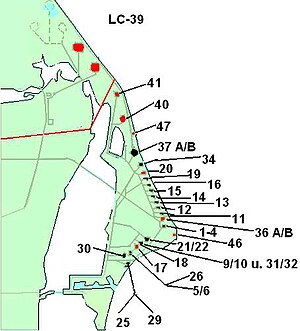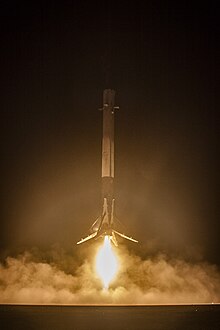Cape Canaveral AFS Launch Complex 13
| CCAFS LC-13 / LZ-1 / LZ-2 | |
|---|---|

|
|
| Launch of Lunar Orbiter 4 | |
| Coordinates | 28 ° 29 '9 " N , 80 ° 32' 40" W |
| Type | Orbital Launch Site / Vertical Landing Site |
| operator | US Air Force / NASA / SpaceX |
| Launch pads | 1 |
| Missiles | Atlas / Falcon 9 / Falcon Heavy |
| First start | 2nd August 1958 |
| Last start | April 7, 1978 |
| Total starts | 52 |
| First landing | December 22, 2015 |
| status | active |
The Cape Canaveral AFS Launch Complex 13 ( LC-13 ) was a launch pad of the Cape Canaveral Air Force Station on Merritt Island , Cape Canaveral in Florida / USA. Since 2015, the area has been designated Landing Zone 1 ( LZ-1 ) and used for landings of the first stages of SpaceX's Falcon 9 rocket . In 2017, Landing Zone 2 ( LZ-2 ) was also built, which is used for landing the second Falcon Heavy Booster. SpaceX also calls the site Landing Complex 1 .
LC-13 launch pad until 1978
Cape Canaveral AFS Launch Complex 13 was used for Atlas rocket launches from the late 1950s to the late 1970s .
In 1966 and 1967 all launches of the lunar orbiter moon probes took place from LC-13 .
In April 1978 the launch complex was shut down. The launch tower was in April 1984 as part of Cape Canaveral Air Force Station to the National Historic Landmark explained.
Landing site LZ-1 from 2015
In January 2015, SpaceX signed an agreement with the US Air Force for the conversion of LC-13 in order to use the space as a future landing site for the reusable first stages of the Falcon 9 . The former launch facilities were demolished and a large, central, concrete landing platform was built. The construction of four smaller landing pads was planned around them, but these were not created directly. The first landing of a rocket stage, and thus the first upright landing by means of a rocket stage's own propulsion system, which carried a spacecraft into orbit, took place on December 22, 2015 with the Falcon 9 flight 20 . Landing attempts with the Falcon 9 main stage on the floating platform Autonomous spaceport drone ship in the Atlantic had already been made beforehand . In the beginning, the place was called Landing Complex 1 , but a short time later it was renamed Landing Zone 1 (LZ-1) to avoid confusion with the other take-off places and with LC abbreviations.
Landing site LZ-2 from 2017
In order to be able to land both boosters of the new Falcon Heavy rocket model , the LZ-2 landing pad was set up next to LZ-1 in 2017. It was first used on February 6, 2018, when the two boosters of the Falcon Heavy's maiden flight successfully landed on LZ-1 and LZ-2 within a few seconds .
Start list
| date | Time ( UTC ) | Missile type | serial number | Upper school | Mission / payload | Remarks |
|---|---|---|---|---|---|---|
| 2nd August 1958 | 22:16 | Atlas B | 4B | |||
| September 18, 1958 | 21:27 | Atlas B | 6B | |||
| April 14, 1959 | 21:46 | Atlas D | 3D | |||
| June 6, 1959 | 17:39 | Atlas D | 5D | |||
| August 11, 1959 | 18:01 | Atlas D | 14D | |||
| 17th September 1959 | 02:09 | Atlas D | 17D | |||
| October 10, 1959 | 03:10 | Atlas D | 22D | |||
| 4th November 1959 | 21:37 | Atlas D | 28D | |||
| November 24, 1959 | 19:48 | Atlas D | 15D | |||
| December 9, 1959 | 00:10 | Atlas D | 31D | |||
| December 19, 1959 | 00:48 | Atlas D | 40D | |||
| January 7, 1960 | 01:40 | Atlas D | 43D | |||
| January 27, 1960 | 01:31 | Atlas D | 44D | |||
| February 12, 1960 | 04:11 | Atlas D | 49D | |||
| February 15, 1960 | Atlas D | Able | Pioneer P31 | Failure: missile exploded on the launch pad | ||
| March 11, 1960 | 00:36 | Atlas D | 51D | |||
| October 11, 1960 | 19:15 | Atlas E. | 3E | |||
| November 30, 1960 | 01:12 | Atlas E. | 4E | |||
| January 24, 1961 | 21:55 | Atlas E. | 8E | |||
| February 24, 1961 | 18:29 | Atlas E. | 9E | First successful flight of the Atlas E rocket | ||
| March 14, 1961 | 04:17 | Atlas E. | 13E | |||
| March 25, 1961 | 01:49 | Atlas E. | 16E | |||
| May 26, 1961 | 02:26 | Atlas E. | 18E | |||
| July 7, 1961 | 04:51 | Atlas E. | 22E | |||
| August 9, 1961 | 04:31 | Atlas F | 2F | |||
| September 9, 1961 | 01:42 | Atlas E. | 26E | |||
| 5th October 1961 | 13:42 | Atlas E. | 30E | |||
| November 10, 1961 | 14:55 | Atlas E. | 32E | US Air Force test capsule with a squirrel monkey . Missile was blown up by the security officer 15 seconds after take-off after an engine malfunction. | ||
| December 1, 1961 | 20:40 | Atlas E. | 35E | |||
| December 20, 1961 | 03:32 | Atlas E. | 36E | |||
| February 13, 1962 | 20:55 | Atlas E. | 40E | Last test flight of the Atlas E rocket | ||
| 17th October 1963 | 02:37 | Atlas D | 197D | Agena | Vela 2 | |
| 17th July 1964 | 08:22 | Atlas D | 216D | Agena | Vela 3 | |
| 5th November 1964 | 19:22 | Atlas D | 289D | Agena | Mariner 3 | |
| July 20, 1965 | 08:27 | Atlas D | 225D | Agena | Vela 5 | |
| August 10, 1966 | 19:26 | Atlas SLV-3 | 5801 | Agena | Lunar Orbiter 1 | |
| November 6, 1966 | 23:21 | Atlas SLV-3 | 5802 | Agena | Lunar Orbiter 2 | |
| 5th February 1967 | 01:17 | Atlas SLV-3 | 5803 | Agena | Lunar Orbiter 3 | |
| May 4th 1967 | 22:25 | Atlas SLV-3 | 5804 | Agena | Lunar Orbiter 4 | |
| August 1, 1967 | 22:33 | Atlas SLV-3 | 5805 | Agena | Lunar Orbiter 5 | |
| 4th March 1968 | 13:06 | Atlas SLV-3A | 5602A | Agena | OGO 5 | |
| August 6, 1968 | 11:16 | Atlas SLV-3A | 5501A | Agena | Canyon 1 | |
| April 13, 1969 | 02:24 | Atlas SLV-3A | 5502A | Agena | Canyon 2 | |
| June 19, 1970 | 11:37 | Atlas SLV-3A | 5201A | Agena | Rhyolite 1 | |
| September 1, 1970 | 01:00 | Atlas SLV-3A | 5203A | Agena | Canyon 3 | |
| 4th December 1971 | 22:30 | Atlas SLV-3A | 5503A | Agena | Canyon 4 | |
| December 20, 1972 | 22:20 | Atlas SLV-3A | 5204A | Agena | Canyon 5 | |
| March 6, 1973 | 09:30 | Atlas SLV-3A | 5202A | Agena | Rhyolite 2 | |
| June 18, 1975 | 09:00 | Atlas SLV-3A | 5506A | Agena | Canyon 6 | |
| May 23, 1977 | 18:13 | Atlas SLV-3A | 5507A | Agena | Canyon 7 | |
| December 11, 1977 | 22:45 | Atlas SLV-3A | 5504A | Agena | Rhyolite 3 | |
| April 7, 1978 | 00:45 | Atlas SLV-3A | 5505A | Agena | Rhyolite 4 |
Landing list
| date | flight | Serial no. 1 | Mission / payload | Remarks |
|---|---|---|---|---|
| December 22, 2015 | Falcon-9 flight 20 | B1019.1 | Orbcomm OG-2 Mission 2 | 1. Landing upright of a rocket stage that put a spacecraft into orbit |
| 18th July 2016 | Falcon 9 Flight Sept. | B1025.1 | Dragon CRS -9 | after 3 landings on the lake platform the 5th successful landing of a Falcon 9 first stage |
| 19th February 2017 | Falcon 9 flight 30 | B1031.1 | Dragon CRS-10 | 8. Successful landing of a Falcon 9 first stage |
| 1st May 2017 | Falcon 9 Flight 33 | B1032.1 | NROL-76 | 10. Successful landing of a Falcon 9 first stage |
| 3rd June 2017 | Falcon 9 Flight 35 | B1035.1 | Dragon CRS-11 | 11. Successful landing of a Falcon 9 first stage |
| August 14, 2017 | Falcon 9 Flight 39 | B1039.1 | Dragon CRS-12 | 14. Successful landing of a Falcon 9 first stage |
| 7th September 2017 | Falcon 9 Flight 41 | B1040.1 | US Air Force X-37B OTV-5 | 16. Successful landing of a Falcon 9 first stage |
| 15th December 2017 | Falcon 9 Flight 45 | B1035.2 | Dragon CRS-13 | 20. Successful landing of a Falcon 9 first stage |
| January 8, 2018 | Falcon 9 Flight 47 | B1043.1 | Zuma | 21. Successful landing of a Falcon 9 first stage |
| February 6, 2018 | Falcon Heavy Flight 1 | B1033.1 B1023.2 B1025.2 |
Falcon Heavy Demonstration Mission | 1. Successful landing of the two boosters |
| April 11, 2019 | Falcon Heavy Flight 2 | B1055.1 B1052.1 B1053.1 |
Arabsat-6A | 2. Successful landing of the two boosters |
| June 25, 2019 | Falcon Heavy Flight 3 | B1057.1 B1052.2 B1053.2 |
STP-2 | 3. Successful landing of the two boosters |
| July 25, 2019 | Falcon 9 Flight 73 | B1056.2 | Dragon CRS-18 | |
| March 7, 2020 | Falcon 9 Flight 82 | B1059.2 | Dragon CRS-20 |
Web links
- Cape Canaveral LC13 in the Encyclopedia Astronautica (English)
- Pictures of LC-13 (English)
- Stephen Clark: SpaceX leases property for landing pads at Cape Canaveral, Vandenberg. February 17, 2015 on spaceflightnow.com
- Stephen Clark: Rocket landing at Cape Canaveral planned after SpaceX launch. December 19, 2015 on spaceflightnow.com
Individual evidence
- ↑ Listing of National Historic Landmarks by State: Florida. National Park Service , accessed July 20, 2019.
- ↑ SciNews: SpaceX CRS-13: Falcon 9 launch & landing, December 15, 2017. December 15, 2017, accessed December 27, 2017 .
- ↑ NASA Video: SpaceX / Dragon CRS-13 Post Launch Briefing. December 15, 2017. Retrieved December 27, 2017 .
- ↑ Stephen Clarc: Live coverage: Falcon Heavy readied for maiden launch Tuesday. Spaceflight Now, February 6, 2018, accessed January 26, 2018 .




